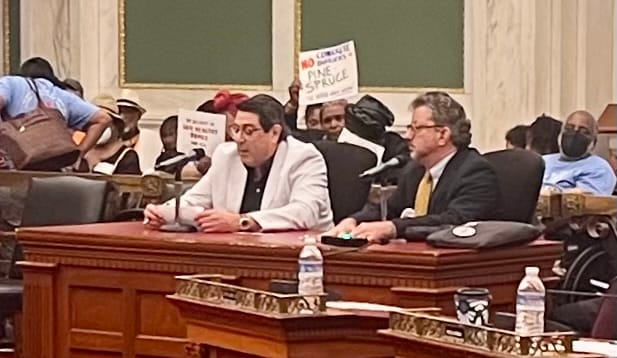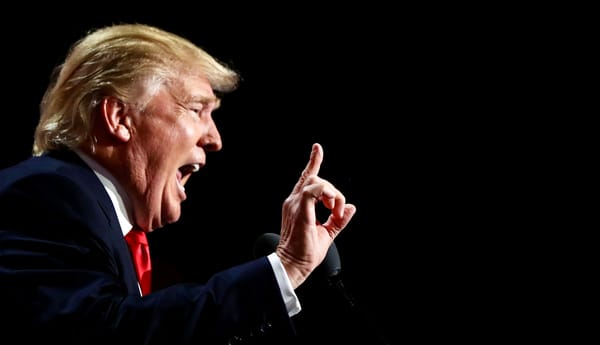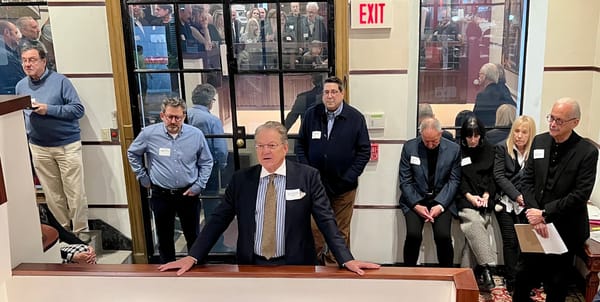The bike fight moves to an issue of the budget

The war has moved from the broad expanse of the ocean to the small inlets along the shore.
The battle is over to what extent the bicycle cult can dictate free movement to the lives of everyone else.
Hearings on a bill to ban even momentary stopping in bike lanes was rocketed through City Council, and while hearings were held, not many Council members attended, and even fewer paid attention.
To placate furious residents, the city proposed adding loading zones to each block.
From intro to passage the bill went like grease through a Canada goose, and with the logic of a Dodo.
What might be coming next are small concrete barriers. The city is thinking of up to $5 million to waste spend on concrete pills, about the height of a curb. (Believe it or not, the city is not sure of the pill’s height.)
The bike cult did not turn out in force on Tuesday, but Stan Horwitz, a bike frenemy I know in real life, testified on behalf of the Bicycle Coalition of Greater Philadelphia, and tipped his hand, perhaps inadvertently.
What he and the Coalition want is “to reduce the use of individual motor vehicles as much as possible.”
What was left unsaid was this: “By making auto ownership as unpleasant as possible.”
And, as I have written before, there is an anti-auto agenda pushed by some of those in power, that no one will admit to.
Evidence is all around us.
I am estimating dozens of Center City parking spots were eliminated to accommodate bike lanes. I am estimating because the city claims it doesn’t have that number.
And another 64 parkings spaces will be lost to loading zones.
Now, add in the city’s rapacious 20% tax on parking lots, and right now Mayor Cherelle Parker wants to raise the cost of parking meters by $1 per hour, from $2 to $3, a 50% hike. Hey — they’re cars, not people, seems to be the thinking.
Not to mention, but I will, the city’s insane parking regulations that can change from street to street, in terms of days and hours in use. Not to mention signs that can hardly be read by a driver seated in the car.
Whew.
Back to the hearing.
Next up was Matthew Wallach (guessing at name, going by what I heard) who started out with the usual bike cult tactic of waving a bloody flag, referencing Spruce and Pine as “where we most recently lost a doctor. A doctor of our community.”
Wallach was happy to use her body, but not her name.
She was Dr. Barbara Friedes, who was killed on Spruce by an alleged drunk driver doing an estimated 50 miles an hour. The reality is that pill-shaped concrete barriers under discussion would not have stopped a car at that rate of speed. No barrier short of a three-foot-high concrete cattle chute would have prevented her death.
The Bicycle Coalition fetishizes the doctor’s death. The Coalition just lives (pardon the pun) for death. But not all deaths.
Paul Boni, a member of the Friends of Pine and Spruce (FOPS), did remember other deaths — four in four weeks.
In the 6th District, a pedestrian was killed by a hit and run; in the 7th District, a person in a wheelchair was killed by a school bus; in the 4th District, a person was killed by a hit and run; in the 3rd District, a bicyclist was killed by a truck.
“All on streets much more dangerous than Pine and Spruce,” said Boni.
It’s fine to increase the budget for Vision Zero, the plan that seeks to reduce traffic deaths, “but don’t waste it,” said Boni. “Spend it where it’s needed the most. $5 million can fund 1,000 speed bumps — that means 100 speed humps in each Councilmanic District. Don’t waste the money on a pet project.”
The $5 million plan is a “boutique project obsession of a small group of bike activists, and unfortunately, the mayor, City Council and city agencies,” said Ken Luongo, a FOPS member.
“There are 300 miles of High Injury streets in Philadelphia and only 1/6 of them are eligible for treatment. But the same few miles of Pine and Spruce” have become an irresistible object, he said.
Referencing community groups that testified about their need for funding, Luongo added, “give it to Ms. Gloria and her Nicetown group who need a new pool. Or to Ms. Symbol who is seeking education improvements. Or to the many people that have testified today about the need for housing repairs. These are positive uses of that money that will help Philadelphia thrive.”
Another suggestion about where to direct the Vision Zero funds came from FOPS board president Lloyd Brotman.
Rather than Pine and Spruce, “instead funds should be earmarked for speed bumps and cameras on streets throughout all districts to protect everyone, especially the largest at-risk group, pedestrians.”
Society Hill resident Debbie Zak Cohen said she favors bike lanes, and added that for 16 years the 9-foot wide bike lane and buffer was used for temporary stops when needed and cyclists maneuvered safely around stopped cars at their discretion.
“There’s never been injuries from merging in and out of traffic,” she said, adding the money could be better spent elsewhere.
Will these arguments prevail, or will they be lost along the shore?


